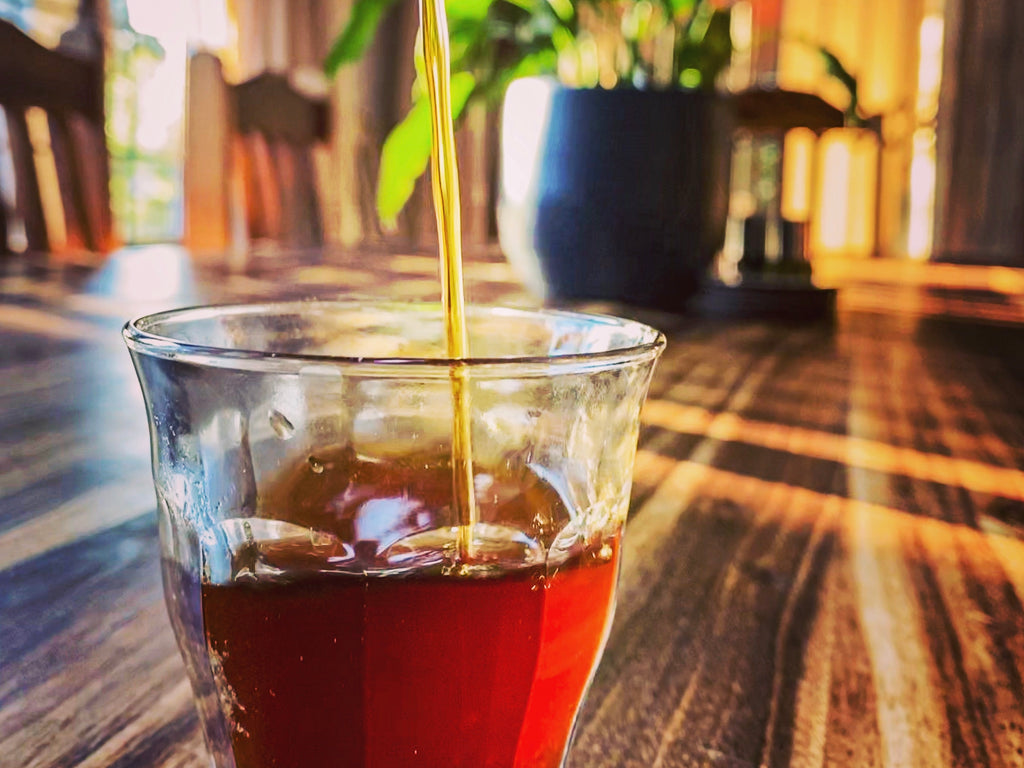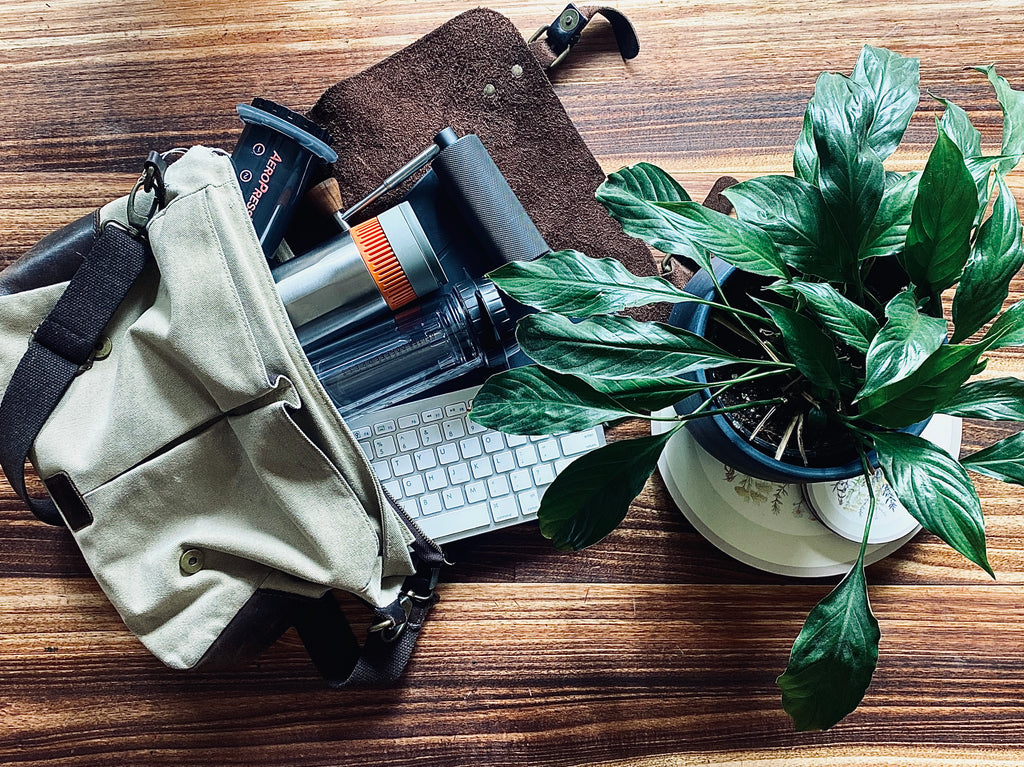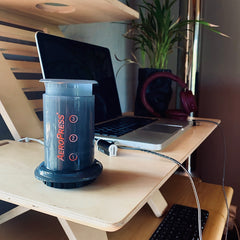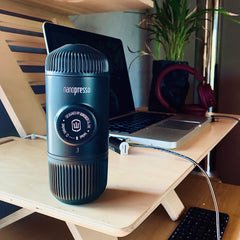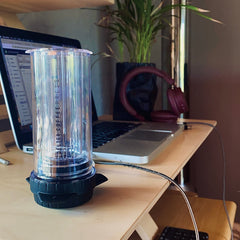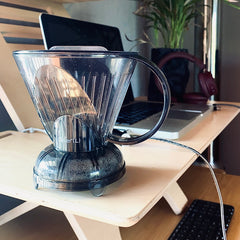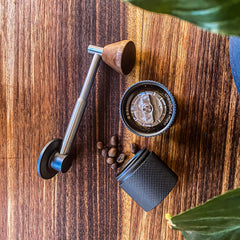All about espresso: channelling and how to avoid it
Making good espresso takes time and effort. From weighing and grinding your beans to pulling your shot, it’s a pretty hands-on and focused process. This makes it all the more bitter (or sour, depending on your extraction) when you put in all that work only to end up with a mediocre-to-terrible-tasting shot to show for it. If this is something you experience regularly, it’s highly likely to be caused by a nasty little phenomenon called channelling.
The concept may intimidate you if this is the first time you’ve come across it, but don’t panic. It’s actually relatively easy to grasp, though actually preventing channelling itself may prove to be a bit harder. Read on and we’ll try to help you understand exactly why it happens, and what you can do about it.
Some background: extraction and channelling
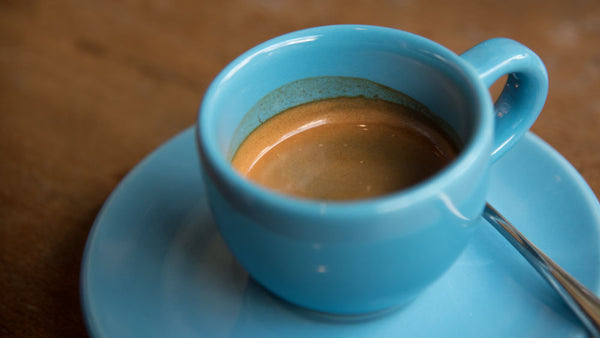
Photo by Arisa Chattasa on Unsplash
If you’re reading this, you likely already know a fair amount of coffee theory, but let’s recap some important foundations.
The way your espresso (and coffee generally) tastes hinges primarily on what’s referred to as extraction: how much soluble coffee is extracted by the water you pass through your puck of ground coffee during the brewing process. Almost every variable you manipulate before and during the brewing process, like grind size and water temperature, goes some way towards controlling the degree of extraction in order to bring out the flavours you want in your espresso.
It’s all about balance. Too much extraction results in harsh, bitter-tasting espresso, whereas too little leads to something more sour and acerbic. Channelling isn’t an extraction problem unique to espresso, but it does come to the fore here more than in other brew methods because of one particular brewing variable: pressure.
In the espresso brewing process, water is forced through your coffee puck under very high pressure, around 9-bar, which facilitates the extraction of a higher concentration of the coffee's soluble compounds in a shorter time than other methods, and also contributes to the complex and concentrated flavours of espresso. Pressure is also behind the production of crema, that layer of delicious golden-brown foam found at the top of a shot of espresso.
Because it’s passed through the puck under such high pressure, water is prone to favour paths of least resistance in the puck itself, being areas in the puck that are less densely packed with ground coffee than others, and that are therefore easier for water to move through. This results in channelling, where water passes more quickly through certain areas (those that are less densely packed) than others, and therefore moves through the puck unevenly overall. This leads to a mix of both under and over-extracted coffee in the puck. When this happens, your espresso’s flavour will be unclear and muddled at best, and a horrible combination of bitterness and sourness at worst.
There’s also a specific kind of channelling called side-channelling, which is what it sounds like, where the coffee bed somehow becomes unseated and water channells through gaps between it and the sides of the portafilter. The border between the stainless-steel edges of the filter basket and your ground coffee is particularly prone to problems. Even minor disturbances of the coffee in this area may cause side channelling, so take care not to bump your portafilter against the group head or workstation after tamping, and make sure your grounds are evenly distributed prior to that. More on distribution a little later.
Because it's so uniquely unpleasant, you can pretty reliably tell when you’ve experienced channelling just by the taste of your shot, but this isn’t the only way to find that out. If you see that shot is pretty watery at the beginning of your pull, or if you pale streaks in what should otherwise be a dark, gooey flow, these are pretty sure visual indicators of channelling. A naked (or bottomless) portafilter is invaluable here, as it lets you see the extraction process clearly from the bottom of the basket. Using one, you’ll be able to see uneven and discoloured flow, and spurting, even more easily.
These are actually relatively easy problems to solve with a few equipment and technique improvements. However, fixing these still might not actually resolve your channelling issues or improve the taste of your shot all that much. That’s because these visual signs are indicative of large channels in the puck which actually don’t affect extraction quite as much as smaller, visually imperceptible microchannels. We’ll get onto how to minimise these a little further on, but for now, let’s talk about:
What actually causes channelling

A shot of espresso as seen from below a bottomless portafilter. Photo by Ryan Spaulding on Unsplash
There are a number of things that may cause channelling, which is part of what makes it a harder problem to solve than we’d like, but the first thing you should take a look at is your grinder and grinder settings. If you have a good grinder, grinding too fine is usually the problem rather than the inverse. When you’re grinding for espresso, you’re already grinding really fine, and it’s not difficult to overshoot the mark somewhat. When you grind too fine it results in excessive resistance in the portafilter basket and therefore excessive pressure when you pull your shot, which increases the likelihood of water seeking out and following a “path of least resistance” and causing channelling. Grinding finer also increases the potential for clumps, which are what they sound like: bits of your grounds that are stuck together. When clumps are tamped, they form disproportionately densely packed areas of your espresso puck, and this can lead to channelling.
If your grinder needs some maintenance or simply isn’t particularly good, you may find that your grounds aren’t too fine, they’re instead inconsistent, which is arguably even worse. If your grinder grinds inconsistently, you end up with coffee grounds of various sizes in the portafilter basket. In this case, your water isn’t going to flow evenly through the puck, instead flowing faster through areas of larger grounds, again causing channelling. If this is a problem you find yourself running into pretty often, it might be a sign that it’s time to upgrade your gear. Consider springing for something like one of Eureka’s Mignon grinders, which are specifically kitted with anti-clumping technology to limit your chances of channelling from the moment you start grinding.
Your basket itself may also be a problem. More specifically, you might be dosing wrong for your basket’s size. Your dose may look fine at first, but coffee grounds expand when they come into contact with water. If you’ve packed your basket too tightly (i.e. with too much coffee), your puck won’t have enough room to expand once you start pulling your shot, and it could end up pushing against the shower screen, causing channelling.
However, above all else, there’s one particular factor that most directly influences your shot’s likelihood of channelling: distribution.
Distribution

Undistributed ground coffee in a portafilter. Photo by Noora AlHammadi on Unsplash
Distribution refers to how your ground coffee is spread (i.e. distributed) within the portafilter basket prior to tamping. You want your grounds distributed evenly throughout the basket to allow for consistent water flow and even extraction. Clumps and general areas of uneven distribution are pretty much guaranteed to create paths of least resistance, and therefore cause channelling. You want to prevent and eliminate them as best you can before you lock your portafilter in and pull your shot, which is exactly what distribution and puck prep is all about.
The kit-free approach
There are a handful of tools you could pick up to this end, and we’ll talk about those in a second, but it’s worth noting that there are several things you can do that will likely improve your distribution without you needing to reach for your wallet just yet.
For example, a firm but gentle tap of your palm on the side of the portafilter helps spread everything a little more evenly inside of it. The same goes for lightly tapping the bottom of the portafilter a few times against your palm or your workstation’s countertop. Importantly, and this goes for all the distribution tools and techniques we’re about to cover, all of this happens prior to tamping. Don’t be tempted to give the portafilter one last tap after you’ve tamped, or you’ll just end up undoing all of your prep work.
There are also some pretty well-known distribution techniques that just take a little hands-on work, like the NSEW (North-South-East-West) method: you simply place your index finger flat across the top of the basket on one side, then use the base of your finger to push your mound of grounds around the basket, first away from your body, then towards it, then to the right and left (hence the name).
There’s also the Stockfleth method, where you place your thumb on the rim of the basket and your index finger straight across it, then rotate your hand and the portafilter below it in opposite directions. Repeat until your grounds are spread evenly to the sides.

GIF from Chris Baca's video on the stockfleth method
If you don’t trust yourself not to accidentally shove a finger right into the basket, you could also always use something straight and flat like a playing card. Just drag it across the rim of the basket like you would your finger in the NSEW method.
All of the above makes a pretty significant difference in terms of distribution, but they’ll only get you so far, especially because they’re mostly effective on the top layer of your grounds, but leave the lower areas relatively untouched. If you want to dive a little deeper, you’re going to need some more specialised kit.
Pre-infusion
While still seeming a little technical, this doesn’t involve any special equipment other than your espresso machine itself (provided it is pre-infusion-capable). Pre-infusion takes place after you’ve attached your portafilter to your machine’s group head and you’ve begun to brew, but before your shot properly begins. The term refers to the process of evenly wetting or saturating your ground coffee under very low pressure, too low to actually extract any espresso. Some machines have a programmable pre-infusion phase, some can do it manually, and there are even hacks to pre-infuse on machines that aren't specifically designed for it.
By saturating the puck in this way, when water pressure is increased as you brew it does so without finding any paths of least resistance, as the entire coffee bed is already evenly saturated once extraction begins.
Dosing cup
Brew Tool's portafilter dosing cup
This isn’t a distribution-specific tool, but there are a number of benefits to grinding into a dosing cup. One is that it can help your distribution somewhat. Giving your grounds a decent shake in the cup before moving them to your portafilter can help break up some of the clumps that occur pretty inevitably when you grind fine enough for espresso.
Wedge distribution tool

Nucleus' Wedge Distribution Tool
Unlike a dosing cup, wedge distribution tools are, as the name suggests, specifically aimed at improving distribution. Though they may come in a number of shapes (the Nucleus Coffee Distributor is a particularly attractive example), a wedge distributor is generally a round, palm-sized tool with a series of sloped metal fins, or wedges, on one end. The idea is that you place the finned end into the portafilter basket prior to tamping and then twist it. The wedges move (distribute) the coffee evenly around the basket, but without actually applying enough pressure to prematurely tamp it, resulting in better distribution.
It’s important to note that, while wedge tools are more effective than a kit-free approach, they mostly influence the top layer of the coffee bed. If you want to ensure that your puck is as evenly distributed as possible, you’ll need something that can get to the clumps found below its surface, such as:
The Weiss Distribution Technique

Named after the man who invented it back in 2005, John Weiss, the Weiss Distribution Technique (WDT) involves using a fine needle or needle-based tool to stir ground coffee in the portafilter prior to tamping. The fine needles break up clumps and even out distribution throughout the basket, not just the top layer of grounds, and this results in reduced channelling and more even extraction overall. For a relatively simple tool, its impact is significant: the Weiss Distribution Technique can reliably improve the quality and consistency of your espresso.
With that said, the WDT does take a little more time and effort than using a wedge tool, which is much quicker by comparison. If you have the time and patience to comb through your ground coffee with a wire tool every time, that's great, but if you're pumping out shots at a rapid pace, like in a commercial setting, a wedge tool might suit you better.
Shower screens and puck screens
Something a little different to the above that we’ve not really touched on just yet is the idea of water dispersion. Water dispersion is generally managed by your espresso machine’s shower screen, which is, simply put, the perforated metal circle at the group head where the water comes out during the brewing process and the last barrier between your espresso puck and the rest of your machine. Shower screens are designed to disperse water evenly over the coffee puck to ensure consistent saturation and, in turn, extraction.

A shower screen by La Marzocco
Shower screens, while variable, aren’t necessarily something you switch out regularly. If you start noticing taste issues in your espresso without having changed up your recipe or the rest of your equipment, that might be a sign that your shower screen is clogged up with coffee residue and needs to be cleaned. In the case that you find your shower screen damaged, you’ll need to replace it. That said, if you wanted, you could also upgrade the shower screen(s) your machine came with for something a little more specialised to further improve your extraction, like these Precision Shower Screens made by IMS.
Where shower screens come standard with any espresso machine, a puck screen, while fairly similar in both appearance and function, is an optional add-on. It’s a thin, perforated metal disk that you place atop your coffee puck in the portafilter prior to attaching it to the group head.

Puck screens function primarily to improve water dispersion, ensuring that your puck is evenly saturated with water as you brew, thereby lowering your risk of channelling and improving extraction. Moreover, because it separates the puck from the grouphead, it also helps keep the shower screen clean, and by extension gives you a little less to think about regarding regular long-term maintenance (though we would still recommend regularly cleaning your shower screen).
Being a relative newcomer to the espresso space, puck screens aren’t often touted as essential pieces of kit, but their advantages are becoming more and more obvious as they rise in popularity and use. Combined with any or all of the approaches and tools above, there’s no doubt that a puck screen will limit your chances of channelling and will improve the quality of your espresso.
To sum up: extracting the salient points
So there you have it. Channelling is a nasty little phenomenon that occurs during the espresso brewing process when water passes unevenly through the coffee puck. Specifically, because of it being pushed through the puck at such high pressures, water is inclined to search for and pass through “paths of least resistance” in areas of the puck where coffee grounds are packed less densely. These areas end up over-extracted, whereas the rest of the puck is left under-extracted, which generally leads to your espresso tasting murky, muddled, and often downright unpleasant. You can often notice channelling visually as you’re brewing, especially if you use a bottomless portafilter, but the surest indicator is in the taste of your shot.
Channelling can be caused by a number of factors, such as grinding too fine or too inconsistently, overfilling your portafilter basket, or neglecting to maintain your shower screen. Improper distribution of grounds, however, stands out as the primary cause for channelling. Improving your distribution prior to tamping is therefore vital to the brewing process, and can be accomplished using a number of puck-prep techniques and specialised equipment.
If channelling is something you’ve been struggling with, you now hopefully understand what it is and how to prevent it. As is usually the case with espresso, making noticeable changes takes a fair amount of trial and error, so don’t be discouraged if the first shot you pull after using a WDT for the first time still doesn’t come out perfect. Keep at it, and soon enough you’ll not only be pulling rich, gooey, flavourful shots, but you’ll also be doing it consistently.
About the author
 Max is currently interning and writing at Cape Coffee Beans. He stumbled into the world of specialty coffee when he discovered James Hoffman’s YouTube channel in the small hours of the morning while putting off a university essay. Ever since he’s been trying to perfect his v60 technique, and now he’s here to write about it and all things coffee too.
Max is currently interning and writing at Cape Coffee Beans. He stumbled into the world of specialty coffee when he discovered James Hoffman’s YouTube channel in the small hours of the morning while putting off a university essay. Ever since he’s been trying to perfect his v60 technique, and now he’s here to write about it and all things coffee too.




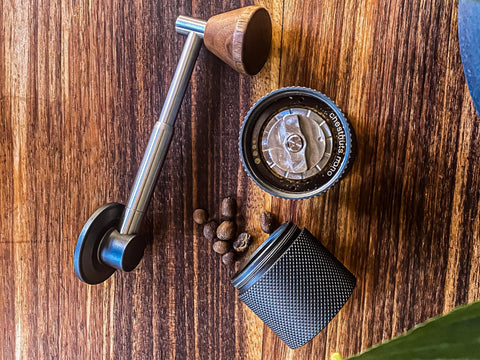



 Max is currently studying towards his Honours in Applied Linguistics at the University of Pretoria. He stumbled into the world of specialty coffee when he discovered James Hoffman’s YouTube channel in the small hours of the morning while putting off an essay. Ever since then, he’s been trying to perfect his v60 brew, and now he’s here to write about it too.
Max is currently studying towards his Honours in Applied Linguistics at the University of Pretoria. He stumbled into the world of specialty coffee when he discovered James Hoffman’s YouTube channel in the small hours of the morning while putting off an essay. Ever since then, he’s been trying to perfect his v60 brew, and now he’s here to write about it too.



 Neil Gouws is one of South Africa's top competitive baristas. Like many of the country's most talented, Neil got his start at Origin Coffee Roasting where he started as a barista and eventually became lead barista and head trainer. He has an impressive competitive record both at the Western Cape regional barista competition and the South African Barista Championship competitions where he has placed 2nd, 3rd & 4th over a period of three years.
Neil Gouws is one of South Africa's top competitive baristas. Like many of the country's most talented, Neil got his start at Origin Coffee Roasting where he started as a barista and eventually became lead barista and head trainer. He has an impressive competitive record both at the Western Cape regional barista competition and the South African Barista Championship competitions where he has placed 2nd, 3rd & 4th over a period of three years.

